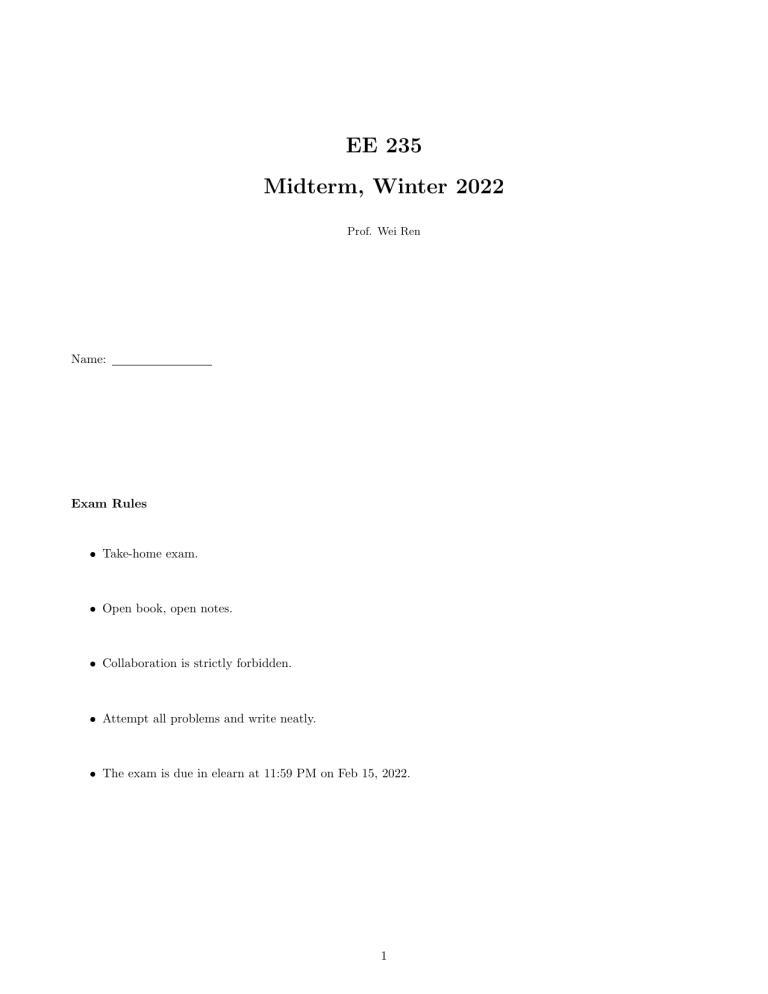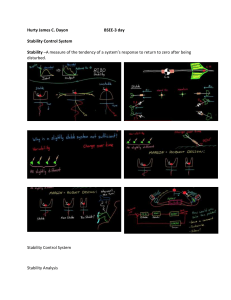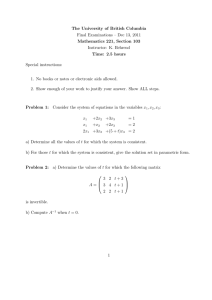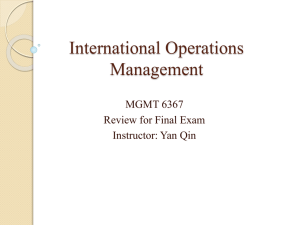
EE 235 Midterm, Winter 2022 Prof. Wei Ren Name: Exam Rules Take-home exam. Open book, open notes. Collaboration is strictly forbidden. Attempt all problems and write neatly. The exam is due in elearn at 11:59 PM on Feb 15, 2022. 1 1. For the nonlinear state equation ẋ1 (t) = x1 (t) + u(t) ẋ2 (t) = 2x2 (t) + u(t) ẋ3 (t) = 3x3 (t) + x21 (t) − 4x1 (t)x2 (t) + 4x22 (t) y(t) = x3 (t) (i) determine the constant nominal solution x̃ and ỹ corresponding to a given constant nominal input ũ(t) = 1. [Hint: The nominal solution is constant.] (ii) linearize the nonlinear state equation about such a nominal. (iii) show that if xδ (t0 ) = 0, then yδ (t) is zero regardless of uδ (t), where xδ , yδ , and uδ represent the deviations from the nominal. 2. Let ẋ = Ax + Bu y = Cx + Du, where x ∈ IR3 , u ∈ IR2 , and y ∈ IR2 . (i) Suppose −1 A= 0 0 −1 0 0 0 −2 1 0 B = 0 1 0 0 1 0 0 C= 0 1 0 and −1 1 D= 0 0 1 (a) Find an invertible matrix P to diagonalize A such that P −1 AP = Λ, where Λ is a diagonal matrix. This should be done by hand. (b) Compute eAt by hand. (c) Assume x(0) = [0.1, 0.2, 0.3]T and u(t) = [sin(t), cos(t)]T , t ≥ 0. Plot x(t) and y(t) using Matlab (No hand computation is required). Attach your code (no need to email me the code). (d) Is the system marginally or asymptotically stable? Why? Is the system BIBO stable? Why? Part (d) should 2 be answered according to the results obtained from (a), (b), and (c). No further computation is allowed. (ii) Suppose 0 A = 0 0 4 3 16 −25 −20 20 and B, C, and D are the same as part (ii). (a) Is it possible to find an invertible matrix P to diagonalize A? If yes, find P and the diagonal matrix. If no, find an invertible matrix P such that P −1 AP = J, where J is the Jordan-form representation of matrix A. This should be done by hand. (b) Compute eAt by hand. (c) Assume x(0) = [0.1, 0.2, 0.3]T and u(t) = [sin(t), cos(t)]T , t ≥ 0. Plot x(t) and y(t) using Matlab (No hand computation is required). Attach your code (no need to email me the code). (d) Is the system marginally or asymptotically stable? Why? Is the system BIBO stable? Why? 3. Let −1 Ẋ(t) = 0 e2t X(t) −1 be a matrix differential equation (X(t) ∈ IR2×2 ). Assume that 1 1 . X(t0 ) = 0 2 (i) Solve the matrix differential equation to find the solution X(t). (ii) Use X(t) to find the transition matrix Φ(t, τ ). (Hint: HW #5: part (b) of exercise 4.2) 4. Let 0 −1 0 x(t) + 1 u(t) 0 −1 0 h i y(t) = 0 1 1 x(t) + u(t). 1/2 ẋ(t) = 0 0 1 1 (i) What is the transfer function? (ii) Assume that x(0) = [0, 0, 0]T and u(t) = 1, t ≥ 0. Compute y(t) by hand. If x(0) = [1, 2, 1]T and u(t) = 1, t ≥ 0, compute y(t) by hand. (iii) Is the state equation above BIBO stable? Why? (iv) Is it marginally or asymptotically stable? Why? 5. Let −1 ẋ(t) = 0 e−t x(t) + u(t) et 0 0 3 h y(t) = 1 i 0 x(t). (i) What is the transition matrix Φ(t, t0 )? (ii) Assume that x(t0 ) = [1, 1]T and u(t) = 1, t ≥ t0 . Compute y(t), t ≥ t0 by hand. 4



